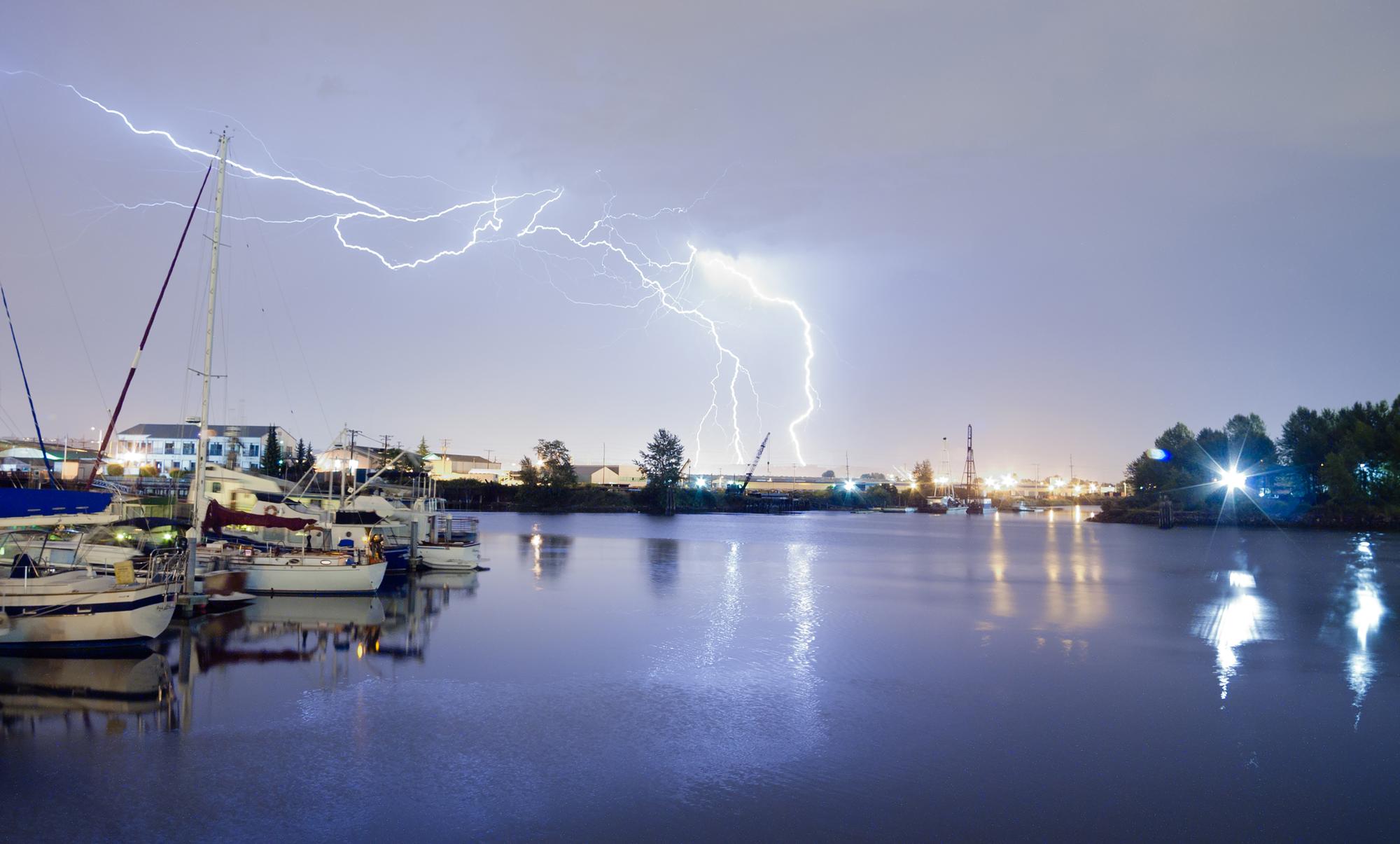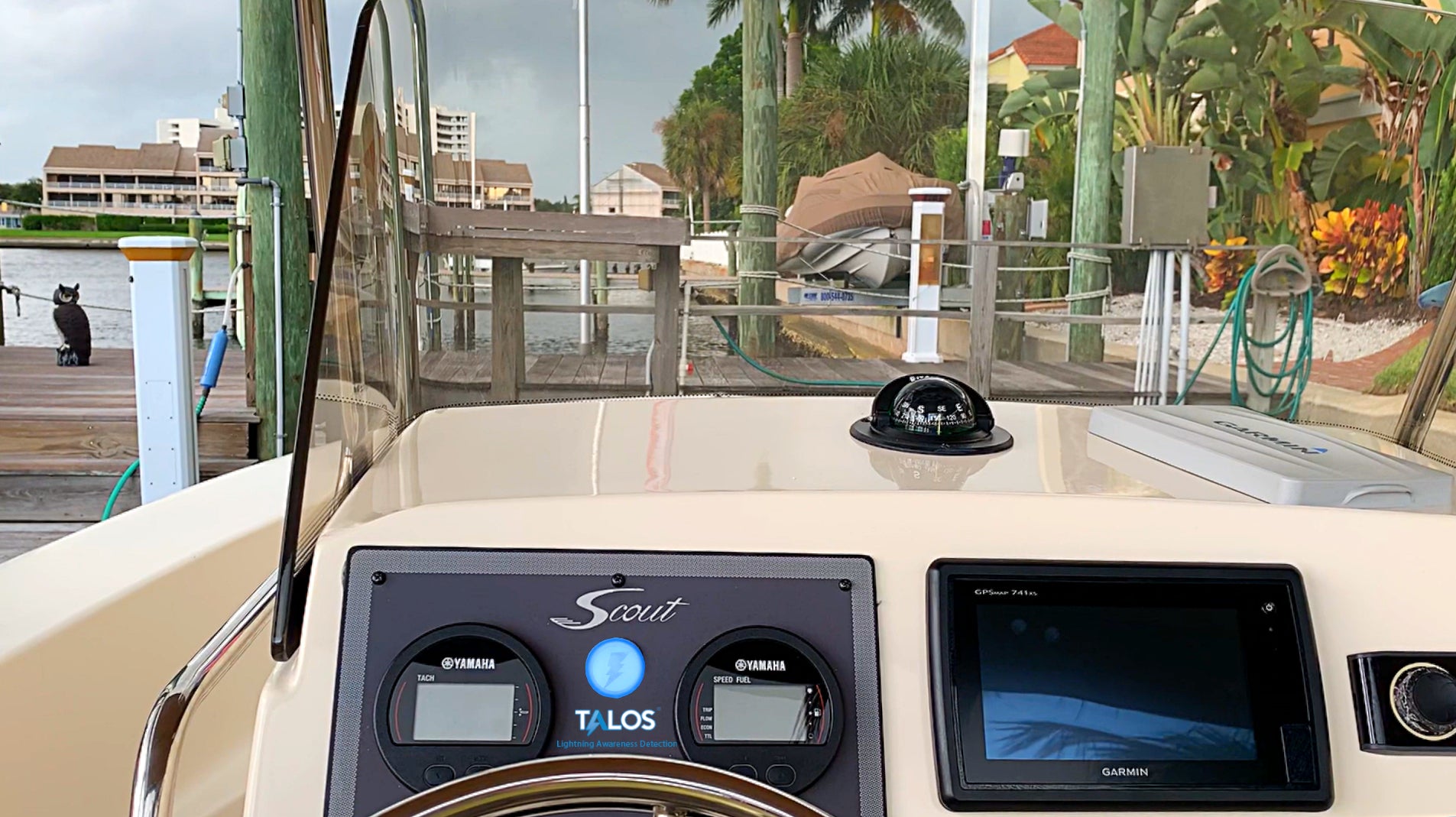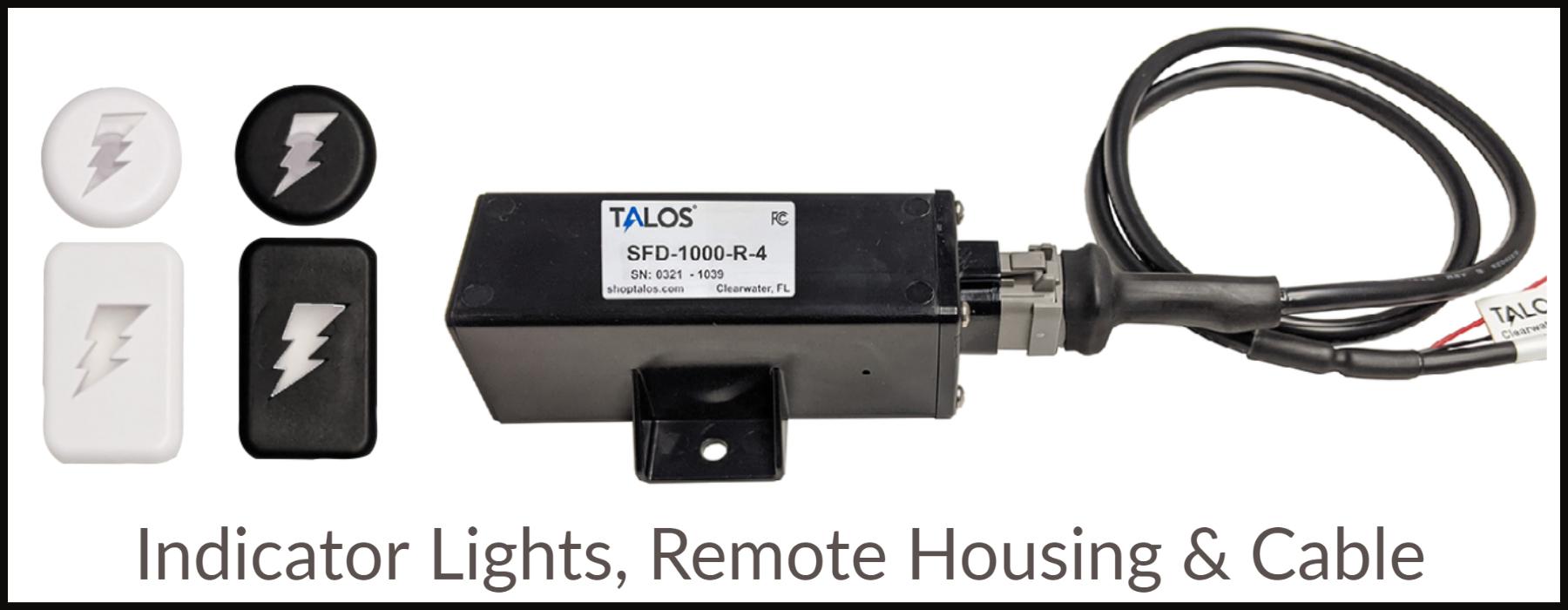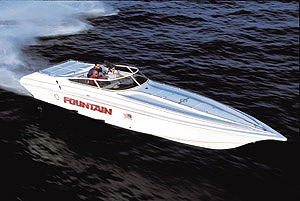Lightning Strikes And Boats: How To Stay Protected
How to avoid getting zapped by lightning on your boat while out on the water.
If you've ever been out on the water when a thunderstorm is approaching, you've probably worried about the possibility your boat could being struck by lightning. That fear is not irrational and understanding the risks associated with lightning and boating as a key aspect of boating safety is a prerequisite for all responsible boat captains on the water.

Above: For thousands of years sailors have tried to avoid lightning storms at sea and many boats have been lost to the ocean in a stormy night. Photo via Pond5.
For thousands of years sailors have tried to avoid thunderstorms at sea. Many experienced boaters still employ the same techniques that ancient seafaring explorers did for recognizing thunder clouds (cumulonimbus cloud) as they form and avoiding them. Knowing what these cloud formations look like and identifying their tell-tale "cotton wool" appearance can help to avoid getting stuck in a hairy situation. Luckily these days boats can be equipped with modern weather equipment and lightning detection systems to help protect the boat and onboard passengers.
How Likely Is Your Boat To Be Struck By Lightning?
The likelihood of your boat being struck by lightning depends on a number of factors. Not surprisingly, sailboats are more likely to get hit by lightning than power boats. According to data, sailboats generally have a 155% greater chance of being strike by lightning than powerboats (40 out of 10,000 for sailboats, as opposed to 5 out of 10,000 for powerboats). On average, a long-distance cruising sailboat will be hit once during its life on the water, with trawlers and large motoryachts topping the list of most likely motor boats to be struck (since they are higher off the water and are often cruising offshore where they tend to encounter more storms).

Above: A thunderstorm with lightning strikes over boats on the water in Commencement Bay, Photo via Pond5.
One rather discouraging statistic is that you have more chance of getting struck by lightning than you do of winning the lottery. Ouch, makes you think twice about playing the numbers doesn't it? Nationwide studies show that most incidents of lightning strike damage occur in the afternoon, during the months of June, July, and August (in the Northern Hemisphere), and most of the strikes occur in Florida, Texas, and North Carolina. Florida has almost double the number of lightning strikes of the number two state, Texas. In fact, it is estimated that between 4-20% of moored sailboats in Florida will be struck every year. A sailboat in Sarasota Florida was even reportedly hit 5 separate times – apparently a standing world record. Of course, lightning strikes throughout the country and lightning bolts everywhere can be equally as powerful.
How To Avoid Lightning Strikes On The Water
We know a great deal about lightning, like why it strikes the earth and what kind of damage it can cause. But why it hits where it does instead of someplace else — well that defies logic. However, though no one can guarantee that you'll never get struck by lightning, you can stack the odds in your favor.
The first line of defense against lightning when boating is to have modern weather detection gear onboard and to make sure you've studied the current weather forecast before you begin your travels. If you see a chance of thunderstorms where you'll be boating, it's obviously best to keep the boat in the marina or harbor and wait until the atmospheric instability passes.
If you find yourself stuck in an approaching thunderstorm, there are some "analog" techniques you can employ to improve your chances of avoiding getting struck. Nearby "ground flashes" nearby indicate that lightning has reach the surface. If thunder can be heard after a flash, a boat captain can count the seconds after the flash to calculate roughly how far away the strike occurred. The typical rule of thumb is 5 seconds per mile in distance. So, for example, if you see a flash and count to 5 before you hear the thunder, the lightning strike was only 1 mile away. If you're able to count to 10 seconds, the lightning strike was roughly 2 miles away, and so on.
Lightning Detection
Lightning detectors on boats are not exactly new, but there have been some recent improvements and innovations making them more accessible and affordable for a wider variety of boaters. Some lightning detectors are not suited for use on boats because they are not waterproof or require constant data connections, plus they may be hard to hear on the water if they don't have a very loud speaker for alerts. Thus it is important to make sure you have the right type of equipment onboard for your vessel.
Located in the "Lightning Capital of the World" in Clearwater Florida, Precision Measurement Technologies has decades of experience in developing and manufacturing state of the art, advanced sensor solutions. The company's newest line of products, called TALOS®️, features the same technology found in expensive weather stations at a more affordable price point for families. This innovative storm front detection system provides situational awareness of approaching storms up to a distance of 25 miles. With solutions for OEM and retail, TALOS is leading the way to provide alerts for any outdoor activity. The products are designed to promote safety and awareness while enjoying outdoor recreational and on-the-water boating activities.

A TALOS lightning detection system onboard a Scout center console boat. Photo by TALOS/Precision Measurement Technologies.
The new TALOS®️ Lightning Alerts System features a self-contained, stand-alone lightning detector device that gives the user real time alerts based on the location of the device and nearby lightning strikes, giving boaters more time to seek shelter.
Boat builders can order ready-to-install solutions for their models that have been designed to include the following features:
- Clean Appearance / Uncluttered Integration On Dash
- Permanent, Space Saving Design
- Real Time Lightning Alerts
- Custom Installations
- A stand-alone lightning detector device

Above: Components of the TALOS storm front lightning detection system. Photo By TALOS/Precision Measurement Technologies.
Although the new TALOS remote lightning detectors are designed primarily for OEMs, end users can also purchase the systems and install themselves.
Lightning Protection
Lightning protection onboard a boat should be installed during the construction of the boat to make sure it is properly designed and integrated to minimize damage in the event of a lightning strike. These systems really need to be custom built and designed on a boat-by-boat basis. There are three major aspects of any good onboard lightning protection for a vessel. These include:
- Grounding
- Bonding
- Electronics Protection
Proper grounding should provide a "conducting path" from the point where the lightning struck down through a system of conductors into the water, without producing sideflashes or blowing a hole in the hull of the boat. To protect the passengers onboard, a bonding system will have conductors designed to short out so that voltage cannot develop between metal fittings and cause fires or dangerous electric sparks. The electronics protection system will limit the power supply and transducer voltages to minimize any damage to onboard systems.

Above: Lightning strikes behind boats in a marina. Photo via Pond5.
Some manufacturers build large grounding plates into the hull bottom to which everything metal aboard gets grounded. Theoretically, the large area in contact with the water dissipates the huge charge of lightning-generated electricity harmlessly into the sea. But sometimes there is so much power sent to the plate that the water in which the plate is submerged gets instantly vaporized — turned to steam in a fraction of a second and the effect is very much like an explosion. This can actually cause a hole to be blown out of the boat where the grounding plate used to be.
However, that doesn't mean you shouldn't ground your boat. It is absolutely imperative that everything that can possibly be damaged by lightning be grounded with nothing less than number eight wire. Anyplace where a grounding wire has to make a turn of 90 degrees or more, you should radius the turn over at least 8 inches. Overlook nothing in your zeal to ground. Electronics, appliances, engine gauges panels, rails, windshields, throttles and clutches, anchor windlasses, outriggers, towers, and all other large metal objects aboard, should all be grounded to a your ship's bonding system. A bonding system that connects all underwater fittings spreads the surge out over a much greater area than a grounding plate. If you don't have a bonding system, at the very least be sure to ground everything to a shaft and prop.
Protecting Your Boat
The American Boat and Yacht Council creates rules and standards for just about everything you can imagine concerning the construction of yachts and ships in the United States. Plumbing, electrics — all come under their purview. The ABYC suggests that the best way to protect a vessel from a lightning strike manuals suggest installing a lightning mast at least one-third the length of the boat in height above the boat, forming what it calls a 60-degree cone of protection.
Cerney agrees that in the best of all possible situations, this would be a fine way to handle lightning protection. Unfortunately, it just isn't very practical. He cites the difficulty getting the required straight path from the rod to the waterline due to sharp bends over the cabin top, around rails, etc. And even if you could, the wire from the lightning rod needs to terminate in a plate hanging in the water which will disperse the charge. All well and good at anchor but how do you keep the plate in the water while underway at 25 or 30 mph?
Easier Protection
The tall sailboat mast next door may reach higher than the radio antenna on your cabin cruiser, but the mast has a broader area at its apex and the spreaders present a more horizontal image to the lightning. Consequently, according to Cerney, the mast is unlikely to have as great an attractive charge potential as the antenna, meaning the powerboat is more likely to be struck.
The horizontal aspect of the sailboat's spreaders may point to the single most important factor in protecting your vessel from a lightning strike. If lightning is attracted to a smaller area with a more concentrated potential charge, logically, increasing the area should diminish the potency of the charge and the chance of being struck. The key word here is horizontal.
Make no mistake. Avoiding a storm by going around it or heading for shelter immediately is by far, the best method of protection. Remember, that you need a good head start if you have a 25-knot boat and the storm is moving at 40 knots. Also remember that lightning sometimes strikes as far as five miles ahead of an approaching storm — in perfectly clear, sunny conditions. Don't bet that you're in a safe area becaue the dark clouds are still on the horizon.
But barring reaching shelter before the storm, the best thing you can do is remember horizontal.
Lay all your antennas down flat. Raise your Bimini top and/or spray dodger if you have one. If you have fishing rods (especially graphite ones — graphite is a superior conductor of electricity), remove them from in-gunwale rod holders or rocket launchers and lay them flat in the cockpit or even better, stow them below. This offers a large, horizontal area. If your boat is equipped with outriggers, lower them into the trolling position, again offering a broad horizontal target.
"I don't know why," says Cerney, "but none of the sport fishing boats I've ever worked on that were struck by lightning have had lightning strike the tower."
Practical Prediction Based On Experience
Will Cerney is an electronics technician in southwestern Florida. Over his 40 or so years in the business, Cerney has worked aboard some 20 to 30 boats each year that have been struck by lightning. Most of them happen to be sailboats. But then the logic erodes. "We've discovered [through our own research] that while a lone sailboat in a lightning storm is an excellent target for a strike, statistically, a powerboat among several sailboats, is a much more likely target even though the sailboat masts are higher."
Cerney explains his theory by admitting that lightning is attracted to vertical objects. But the top-most point of the vertical object carries an increasingly greater potential for lightning strikes the smaller it gets. Something that presents a "pinpoint to the sky" has a greater potential of a strike than something that presents a broader expanse, of say, a square meter. The charge potential involved in attracting a lightning strike can be as much as one million volts per square meter. If you concentrate the charge into an area smaller than a square meter, the potential charge increases exponentially. In other words, that same one-million-volts-per-square-meter charge potential becomes two million volts when concentrated in an area of one-half square meter. Reduce the area further to the size of that pinpoint, or perhaps a fishing boat outrigger or the tip of a VHF or GPS antenna, the potential charge can increase to an equivalent of a billion volts.
What To Do In A Lightning Storm On A Boat
Once you encounter a lightning storm, get everyone below. If the helmsman must stay at the wheel, he or she should try to keep one hand in his or her pocket at all times. Don't hold onto the wheel with one hand and the throttle or windshield with the other. Better still, if you have an autopilot, throttle back to idle speed, set the autopilot, and keep both hands in your pockets.
So whether you're chunking for tuna off Gloucester or cruising through Wood's Hole on your way from Mattapoisett to Maathuh's Vinyid, remember, Mother Nature doesn't care about statistics. Keep a cool head, make preparations before the storm strikes, and chances are excellent that you'll sail away without a problem.
Further Research
What Is Lightning?
Shuffling your feet across a carpet in a room with low humidity can generate enough friction to cause static electricity that will spark (arc) when you touch the doorknob. Why? Because opposites attract. When the attraction between the negative charges in your body and the positive charges in the doorknob is greater than the insulation properties of the air, the charge from one side arcs or jumps to the other side. Scientists claim that lightning, too, is a product of friction. They're reasonably certain that lightning happens when warm air rises in an updraft, or cold air descends in a down draft, causing friction. This friction, in turn, causes static electricity that builds up with (usually) negative charges in the clouds and positive charges on the ground. The resulting arc is lightning. (Intra-cloud lightning also happens in similar fashion. Something we called "heat lightning" as children.)












